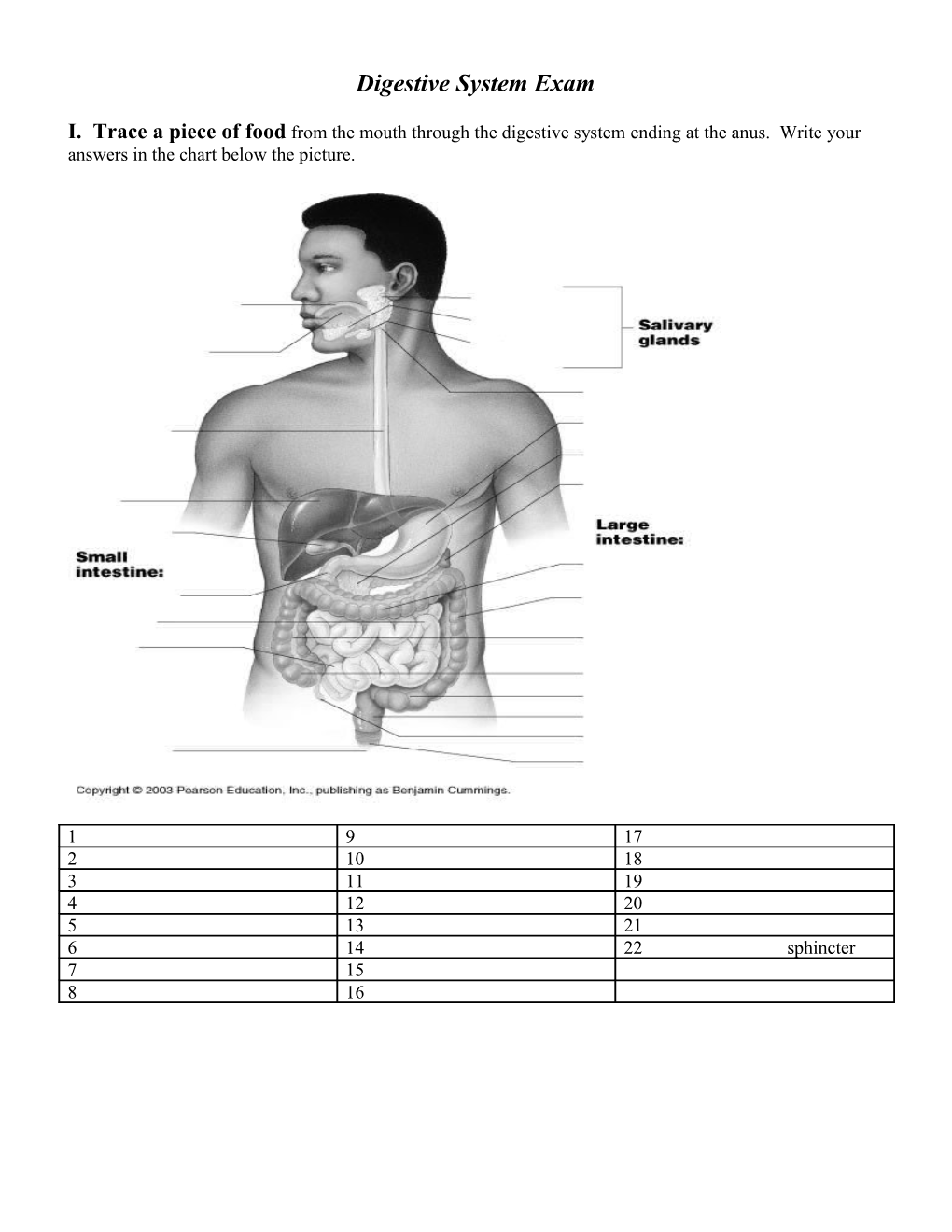Digestive System Exam
I. Trace a piece of food from the mouth through the digestive system ending at the anus. Write your answers in the chart below the picture.
1 / 9 / 172 / 10 / 18
3 / 11 / 19
4 / 12 / 20
5 / 13 / 21
6 / 14 / 22 sphincter
7 / 15
8 / 16
II. Short Answer
1. / The opening on the terminal end of the alimentary canal is called the ____.2. / The fleshy, fingerlike projection of the soft palate, which extends downward from its posterior edge, is the ______.
3. / The upper, expanded part of the stomach lateral to the cardiac region is the ______.
4. / Folds in the stomach lining that allow for expansion are called ______.
5. / Food that resembles heavy cream after being processed in the stomach is called ______.
6. / Baby, or milk teeth are also called ______.
7. / The gums are also referred to as the ______.
8. / Bile breaks large fats globules into smaller ones in a process known as ______.
9. / Deglutition is another name for ______.
10. / The emetic center causes ______.
11. / The amino acids that cannot be made buy the cells & therefore must be ingested are said to be ______.
III. Multiple choice:
1. / Which of the following is NOT an organ of the alimentary canal: a) esophagus b) mouthc) teeth d) pharynx e) stomach
2. / Which of the following is the correct order through which food passes in the alimentary canal:
a) mouth, esophagus, pharynx, stomach, small intestine, large intestine
b) mouth, pharynx, esophagus stomach large intestine, small intestine
c) Pharynx, mouth, esophagus, stomach, large intestine, small intestine
d) mouth, pharynx, esophagus, stomach, small intestine, large intestine
3. / When full, the stomach can hold approximately: a) 3 liters of food b) one gallon of food
c) 2 liters of food d) 1 liter of food e) two gallons of food.
4. / The small intestine extends inferiorly from the : a) pyloric sphincter to the ileocecal valve
b) ileocecal valve to the appendix c) appendix to the sigmoid colon
d) cardioesophageal sphincter to the pyloric sphincter e) sigmoid colon to the anus
5. / Which of the following is the middle section of the small intestine: a) descending colon
b) duodenum c) ascending colon d) jejunum e) ileum
6. / The “gatekeeper” of the small intestine that regulates food movement into it is the:
a) hepatopancreatic ampulla b) jejunum c) pyloric sphincter
d) external anal sphincter e) ileum
7. / The primary function of the small intestine is: a) mineral secretion b) waste secretion
c) vitamin conversion d) water absorption e) food absorption
8. / Which of the following is NOT a subdivision of the large intestine: a) colon b) rectum
c) cecum d) appendix e) duodenum
9. / Amylase is an enzyme that digests: a) starch b) fat c) minerals
d) vitamins e) protein
10. / The number of permanent teeth in the adult mouth is: a) 28 b) 32 c) 24
d) 20 e) 36
11. / The chisel-shaped teeth, like those in the front that are adapted for cutting are the: a) molars
b) canines c) incisors d) premolars e) wisdom teeth
12. / Pancreatic enzymes for digestion are secreted into the: a) stomach b) duodenum
c) ileum d) jejunum e) mouth
13. / Buildup of bile in the liver leading to bile pigments circulating through the body would lead to:
a) cyanosis b) hepatitis c) jaundice d) cirrhosis e) no problem man
14. / The sequence of steps in which large food molecules are broken down to their building blocks by enzymes is called: a) propulsion b) absorption c) chemical digestion
d) mechanical digestion e) ingestion
15. / Swallowing & peristalsis both assist in: a) ingestion b) mechanical digestion
c) chemical digestion d) propulsion e) absorption
16. / Which of the following is NOT one of the carbohydrates that our digestive system breaks down to simple sugars: a) maltose b) starch c) sucrose d) cellulose e) lactose
17. / Transport of digested end products from the GI tract to the blood or lymph is called:
a) propulsion b) defecation c) absorption d) digestion e) ingestion
18. / The nutrient that is first to be chemically digested is: a) starch b) vitamins
c) fat d) minerals e) proteins
19. / The journey of chyme through the small intestine takes: a) 1-2 days b) 1 week
c) 1-3 hours d) 18-24 hours e) 4-6 hours
20. / The build up of larger molecules or structures from smaller ones is called: a) glycolysis
b) catabolism c) carbolysis d) anabolism e) metabolism
21. / ATP is produced in greatest quantity during: a) the electron transport chain b) glycolysis
c) fat metabolism d) the Krebs cycle e) protein metabolism
22. / Inorganic substances that the body needs & must ingest are: a) vitamins b) carbon
c) minerals d) complete proteins e) coenzymes
IV. True or False
1. / The alimentary canal is also called the gastrointestinal tract2. / The rhythmic, wavelike propelling mechanism of the alimentary canal is called peristalsis.
3. / A tooth is similar to hair in that it has no blood supply associated with it.
4. / The small intestine is said to be small because it is shorter than the long intestine.
5. / Small pocketlike sacs in the large intestine are called haustra
6. / The enamel found on teeth is the hardest substance in the body.
7. / The stomach is the site of early protein digestion.
8. / Enzymes of the microvilli are called brush border enzymes.
9. / It is best to have HDL & LDL in equal amounts in the bloodstream.
10. / The anal canal has a voluntary sphincter only.
